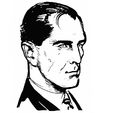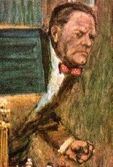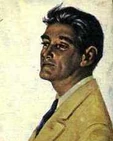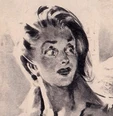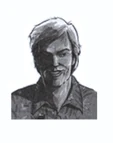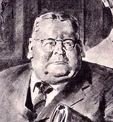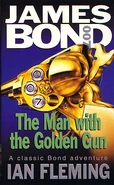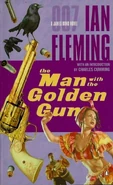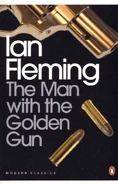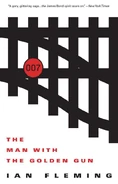The Man with the Golden Gun is the twelfth and final novel written by Ian Fleming, featuring the fictional British Secret Service agent James Bond. It was published posthumously in the United Kingdom by Jonathan Cape in 1965. This novel is stylistically different from and less detailed than Fleming's other works.
The novel was adapted in 1966 as a comic strip in the Daily Express newspaper, and in 1974 as the ninth film in the EON Productions James Bond series with Roger Moore playing Bond.
Plot
It has been nearly a year since James Bond disappeared, and was presumed dead during his mission to Japan. Then, out of the blue, a man claiming to be Bond appears in London and demands to see M. After much scrutinizing and interrogation, the man's identity is confirmed, but during his debriefing interview with M, Bond tries to kill him with a cyanide pistol. The attempt, however, fails.
Meanwhile, the British Secret Service have learned that after attacking Blofeld's castle in Japan (chronicled in You Only Live Twice), Bond suffered a head injury and subsequent amnesia. After living as a Japanese fisherman for several months, Bond headed north, into the Soviet Union, to learn his true identity. While there, he was brainwashed and programmed to kill M on returning to England.
Now deprogrammed, Bond is eager to prove himself worthy of again being a 00 agent. M assigns him to Jamaica, to locate and gain the confidence of Francisco (Paco) "Pistols" Scaramanga, an assassin, known as the man with the golden gun, because of his golden .45 calibre revolver.
Bond is assigned to kill him, after having killed several SIS agents.
In mid-assignment, Bond, who has managed to become Scaramanga's temporary personal assistant under the name of Mark Hazard, learns that Scaramanga is involved with a syndicate of American gangsters and the KGB, who are working several schemes, including the destabilization of Western interests in the Caribbean sugar industry, running drugs into America, smuggling women from Mexico into America and launching casinos in Jamaica. Initially unaware of Bond's presence in Jamaica, Felix Leiter has also been recalled to duty by the CIA and assigned to Scaramanga's hotel staff.
Bond kills Scaramanga during a train journey, with the assistance of Felix Leiter and his former secretary, Mary Goodnight, now assigned to the Kingston station of the Service. Leiter goes one step further and liquidates Scaramanga's gangster allies. In the process of all this, both Bond and Leiter are badly wounded, though they survive. Bond is offered a knighthood (KCMG—Bond already has CMG) for services past and present to Britain—but he turns it down because of his love for anonymity.
Characters
Trivia
- The novel makes reference to events in the short story "The Property of a Lady", which had been published in a special Sotheby's Auction House publication the previous year. This reference would have been lost on the general public, however, who would not get to read the story until it appeared in the paperback edition of Octopussy and The Living Daylights in 1967.
- Being the last James Bond novel by Ian Fleming, this is actually the first time M's full name, Admiral Sir Miles Messervy, is ever said. In previous novels, any reference to M's name had been censored by 'dashes'.
The controversy over the novel
The Man with the Golden Gun novel has been a controversial and speculative subject since its publication in 1965, the year after Ian Fleming died. Supposedly, since Fleming died before completing the final draft manuscript, speculation is that the novel was edited and finished by other writers before publication. Kingsley Amis often has received credit for either completing or editing The Man with the Golden Gun, but this has been denied by several sources, including Andrew Lycett in the biography Ian Fleming: The Man Behind James Bond, claiming Fleming had finished it and was subsequently read and edited only by Fleming's editor William Plomer. John Cork, co-author of James Bond, The Legacy (and producer of the documentaries included to the Special Edition DVD releases of the James Bond films) also claims that Fleming had finished it and that he, Cork, actually had seen the original un-edited typescript—although he admits Amis had read it and had offered ideas that were not implemented. The introduction to the Titan Books reprint edition of the Colonel Sun comic strip explicitly describes the Golden Gun manuscript as "unfinished" at Fleming's death, and credits Plomer with polishing it for publication; the book also supports Cork's account that Amis's involvement was restricted to unimplemented suggestions for the manuscript.
The fact that Fleming reportedly was writing another Bond novel or short story at the time of his death (excerpts from which can be found in John Pearson's The Life of Ian Fleming and the 007forever.com website) adds credence to the idea that Fleming felt the novel was finished before he died, however, these fragments may pre-date his writing of The Man with the Golden Gun.
In the New Statesman, after the novel's release, Amis called it "a sadly empty tale, empty of the interests and effects that for better or worse, Ian Fleming made his own."
Perhaps, due to the rumours of ghostwriters and revisions, some sources have suggested that the novel was some sort of "lost" manuscript; this is untrue.
Comic strip adaptation
- Main article: James Bond comic strips

Fleming's original novel was adapted as a daily James Bond comic strips which was published in the British Daily Express newspaper and syndicated around the world. The adaptation ran from January 10 to September 10, 1966. The adaptation was written by Jim Lawrence and illustrated by Yaroslav Horak, both of whom were starting long tenures with the comic strip. The strip was reprinted by Titan Books in the early 1990s and again in 2004 as part of The Man with the Golden Gun anthology that also includes The Living Daylights.
Covers

